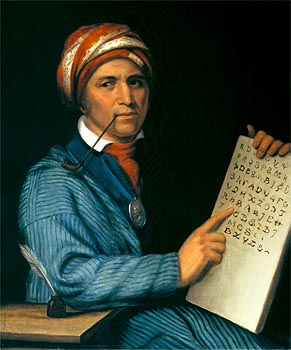|
|
|
Wampum |
Crafted from white and purple shells from west Atlantic whelks and clams and strung as beads, wampum served various purposes as money, ornament, representational art, and record-keeping. For many western scholars or earlier diplomats, wampum represented American Indians' nearest equivalent to writing or literacy, especially because it was chiefly used by the Iroquois Confederation, the group of Indian Tribes whose government most resembled European governments in terms of diplomacy and more-or-less written constitutions.
 |
 |
 |
 |
 |
 |
As the belts above demonstrate, wampum writing is pictographic or ideographic, much like Egyptian or Mayan hieroglyphs, which directly represent the visual form of the object described, though this form can be stylized beyond common recognition:
 Aztec
hieroglyph
Aztec
hieroglyph
 Egyptian
hieroglyph
Egyptian
hieroglyph
 Mayan hieroglyph
Mayan hieroglyph
In contrast, the western alphabet is not a graphic but a phonetic writing system.
That is, it represents the sounds of language, not the things language representes
written word: cat
> sound: /kaet/ > meaning:

Pictures have the advantage of not entirely requiring the language--for instance, a cat in an Egyptian hieroglyph may indicate a cat to later observers. But those observers can't look at it and determine how to speak what is represented.

Also visual signs can be more ambiguous than sounds, and different observers can attach different meanings. Wampum required a reader trained by an elder to speak the meaning of certain signs on a certain belt. Therefore wampum is a hybrid of speech and writing, of traditional and modern cultures. Technically, such writing may be referred to as aides-memoire or memory-aids, like tying a string around your finger.
 |
 |

Another form of writing among North American Indians:
Lakota winter
counts, pictorial calendars that some Lakota (Sioux)
and other Plains Indians kept to mark the
passage of time, reckoned in winters. Each year is named
for a notable event.
 |
 |

also petroglyphs or rock-writing
 |
 |
Addendum
+ the phonetic Phoenician or Western alphabet originated as pictographs
For instance, most common basic sound is /a/ as in "say ah" or the common western herd animal "ox."


Sequoyah (c. 1770-1843)
a.k.a. George Gist or George Guess
(portrait by Charles
Bird King, 1828)
inventor of
Cherokee Syllabary 1821
see also
Cherokee Phoenix
(founded 1828, discontinued 1834 during Cherokee Removal)

